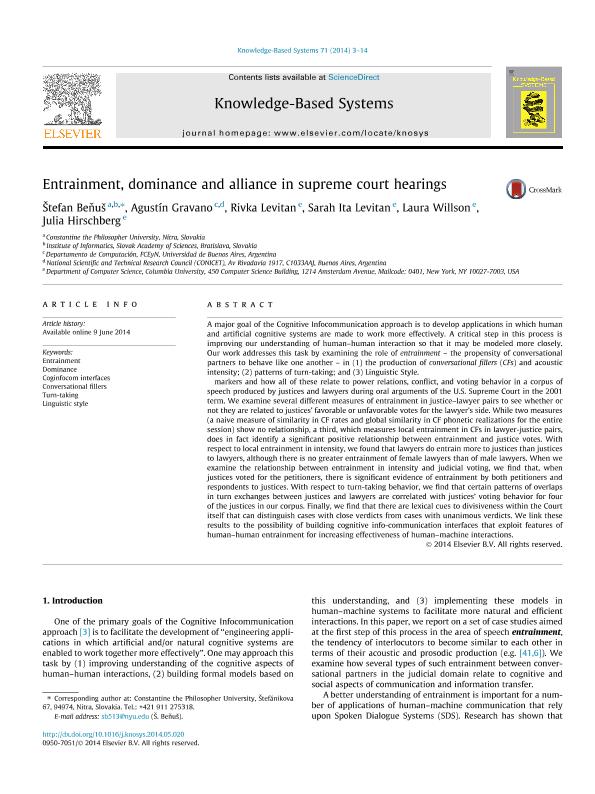Artículo
Entrainment, dominance and alliance in supreme court hearings
Beňuš, Stefan; Gravano, Agustin ; Levitan, Rivka; Levitan, Sarah Ita; Willson, Laura; Hirschberg, Julia
; Levitan, Rivka; Levitan, Sarah Ita; Willson, Laura; Hirschberg, Julia
 ; Levitan, Rivka; Levitan, Sarah Ita; Willson, Laura; Hirschberg, Julia
; Levitan, Rivka; Levitan, Sarah Ita; Willson, Laura; Hirschberg, Julia
Fecha de publicación:
11/2014
Editorial:
Elsevier Science
Revista:
Knowledge-Based Systems
ISSN:
0950-7051
Idioma:
Inglés
Tipo de recurso:
Artículo publicado
Clasificación temática:
Resumen
A major goal of the Cognitive Infocommunication approach is to develop applications in which human and artificial cognitive systems are made to work more effectively. A critical step in this process is improving our understanding of human-human interaction so that it may be modeled more closely. Our work addresses this task by examining the role of entrainment - the propensity of conversational partners to behave like one another - in (1) the production of conversational fillers (CFs) and acoustic intensity; (2) patterns of turn-taking; and (3) Linguistic Style. markers and how all of these relate to power relations, conflict, and voting behavior in a corpus of speech produced by justices and lawyers during oral arguments of the U.S. Supreme Court in the 2001 term. We examine several different measures of entrainment in justice-lawyer pairs to see whether or not they are related to justices' favorable or unfavorable votes for the lawyer's side. While two measures (a naive measure of similarity in CF rates and global similarity in CF phonetic realizations for the entire session) show no relationship, a third, which measures local entrainment in CFs in lawyer-justice pairs, does in fact identify a significant positive relationship between entrainment and justice votes. With respect to local entrainment in intensity, we found that lawyers do entrain more to justices than justices to lawyers, although there is no greater entrainment of female lawyers than of male lawyers. When we examine the relationship between entrainment in intensity and judicial voting, we find that, when justices voted for the petitioners, there is significant evidence of entrainment by both petitioners and respondents to justices. With respect to turn-taking behavior, we find that certain patterns of overlaps in turn exchanges between justices and lawyers are correlated with justices' voting behavior for four of the justices in our corpus. Finally, we find that there are lexical cues to divisiveness within the Court itself that can distinguish cases with close verdicts from cases with unanimous verdicts. We link these results to the possibility of building cognitive info-communication interfaces that exploit features of human-human entrainment for increasing effectiveness of human-machine interactions.
Archivos asociados
Licencia
Identificadores
Colecciones
Articulos(OCA CIUDAD UNIVERSITARIA)
Articulos de OFICINA DE COORDINACION ADMINISTRATIVA CIUDAD UNIVERSITARIA
Articulos de OFICINA DE COORDINACION ADMINISTRATIVA CIUDAD UNIVERSITARIA
Citación
Beňuš, Stefan; Gravano, Agustin; Levitan, Rivka; Levitan, Sarah Ita; Willson, Laura; et al.; Entrainment, dominance and alliance in supreme court hearings; Elsevier Science; Knowledge-Based Systems; 71; 11-2014; 3-14
Compartir
Altmétricas



